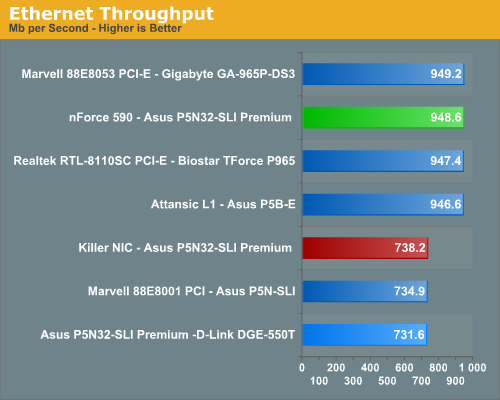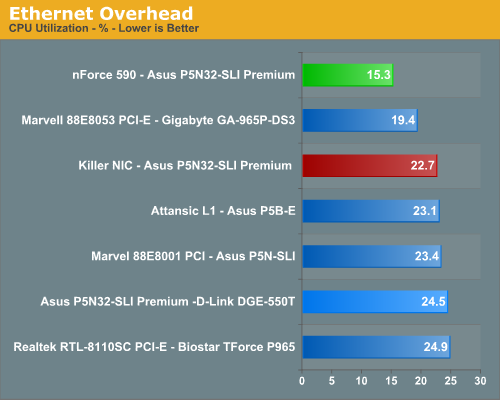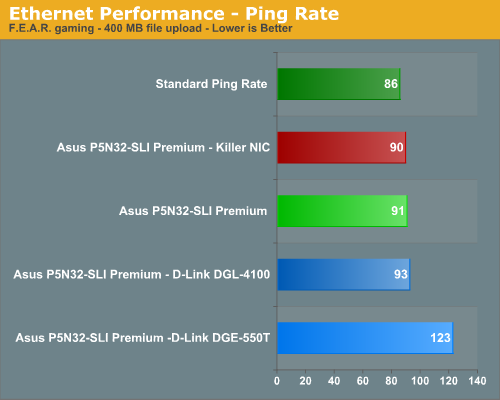BigFoot Networks Killer NIC: Killer Marketing or Killer Product?
by Gary Key on October 31, 2006 2:00 AM EST- Posted in
- Networking
Ethernet NIC Performance
Our current motherboard test suite includes LAN performance measurements and we will utilize this same test today. All of the boards listed utilize PCI or PCI Express based controllers with the only difference being the supplier of the core logic.
The Windows 2000 Driver Development Kit (DDK) includes a useful LAN testing utility called NTttcp. We used the NTttcp tool to test Ethernet throughput and the CPU utilization of the various Ethernet Controllers used on the Intel motherboards.
We set up one machine as the server; in this test, an Intel system with an Intel CSA Gigabit LAN connection. Intel CSA has a reputation for providing fast throughput and is a logical choice for our Gigabit LAN server.
On the server side, we used the following Command Line as suggested by the VIA whitepaper on LAN testing:


No real surprises here as the Killer NIC has a Marvell PHY and utilizes the PCI interface for operation. The throughput rates and CPU utilization of the Killer NIC was very competitive with our other PCI based solutions. However, the NVIDIA nForce 590SLI had the best overall performance numbers in these tests. BigFoot Networks was adamant about the fact they concentrated on lower latency and not improving throughput on the card since most network connections while gaming will not saturate the PCI bus.
Ethernet Outbound Ping Performance
Our final benchmark takes a look at the ping performance of each of our products while playing F.E.A.R. and uploading a 400 MB file to a separate client on another network. Our D-Link DGL-4100 router and the NVIDIA nForce 590SLI include packet prioritization for outbound traffic while gaming. We decided to see how well these solutions stacked up with the Killer NIC that can also prioritize inbound traffic.

All three of our products that advertise packet prioritization are within 3% of each other in the numbers with our D-Link DGE-550T trailing by around 33%. Why a serious gamer would actually want to upload large files while playing online is beyond us but in case you want to then our three solutions provide the capability to do so without an issue. However, be aware that throughput suffered by an average of 44% for the upload file test with our three solutions when compared to the D-Link NIC during testing.
Our current motherboard test suite includes LAN performance measurements and we will utilize this same test today. All of the boards listed utilize PCI or PCI Express based controllers with the only difference being the supplier of the core logic.
The Windows 2000 Driver Development Kit (DDK) includes a useful LAN testing utility called NTttcp. We used the NTttcp tool to test Ethernet throughput and the CPU utilization of the various Ethernet Controllers used on the Intel motherboards.
We set up one machine as the server; in this test, an Intel system with an Intel CSA Gigabit LAN connection. Intel CSA has a reputation for providing fast throughput and is a logical choice for our Gigabit LAN server.
On the server side, we used the following Command Line as suggested by the VIA whitepaper on LAN testing:
Ntttcpr -m 4,0,‹server IP› -a 4 -l 256000 -n 30000
On the client side (the motherboard under test), we used the following Command Line:Ntttcps -m 4,0,‹client IP› -a 4 -l 256000 -n 30000
At the conclusion of the test, we captured the throughput and CPU utilization figures from the client screen.

No real surprises here as the Killer NIC has a Marvell PHY and utilizes the PCI interface for operation. The throughput rates and CPU utilization of the Killer NIC was very competitive with our other PCI based solutions. However, the NVIDIA nForce 590SLI had the best overall performance numbers in these tests. BigFoot Networks was adamant about the fact they concentrated on lower latency and not improving throughput on the card since most network connections while gaming will not saturate the PCI bus.
Ethernet Outbound Ping Performance
Our final benchmark takes a look at the ping performance of each of our products while playing F.E.A.R. and uploading a 400 MB file to a separate client on another network. Our D-Link DGL-4100 router and the NVIDIA nForce 590SLI include packet prioritization for outbound traffic while gaming. We decided to see how well these solutions stacked up with the Killer NIC that can also prioritize inbound traffic.

All three of our products that advertise packet prioritization are within 3% of each other in the numbers with our D-Link DGE-550T trailing by around 33%. Why a serious gamer would actually want to upload large files while playing online is beyond us but in case you want to then our three solutions provide the capability to do so without an issue. However, be aware that throughput suffered by an average of 44% for the upload file test with our three solutions when compared to the D-Link NIC during testing.










87 Comments
View All Comments
stmok - Tuesday, October 31, 2006 - link
Yeah, I do agree.Its targetting at the wrong crowd. This product should be really for the hardcore enthusiasts. (I'm talking about those who actually use the command line on a regular basis). You don't expect clueless Windows users start tinkering with Linux, do you? :)
As for SLI and Crossfire? Its a bloody joke.
You buy two video cards today, and in 12 months time, they'll be outperformed by a single next generation video card. Yeah, money well spent there, isn't it?
stmok - Tuesday, October 31, 2006 - link
To be honest, if they opened up the specs for the card, and work with the community, you'd have a different product. (So they only focus on selling hardware and advising enthusiasts in how to develop software solutions for the card).yyrkoon - Tuesday, October 31, 2006 - link
So the fact that Intels NIC cards regularly perform better than atleast 99% of the competition, and the fact they have made a PCI-E card is completely lost on you ?BTW the price of the Intel card is FAR less . . .
Zebo - Tuesday, October 31, 2006 - link
It's you who is stupid. Video you get your monies worth unlike this POS, anywhere from 60-75% inprovement moving to that second card in SLI/xfire config.mlau - Tuesday, October 31, 2006 - link
as i said, i think this card is targeted at the wrong crowd. but then i don't doubtthat the windows network stack is a POS and offloading it completely to a piece of
hardware will free the host cpu for other tasks.
as for sli/xfire, performance improvements are almost not noticeable (and sometimes
perf decreases). noone except a few impressionable 12 year olds care about your fps
in fear and other shooters. i play games to be entertained and not to watch the fps
meter and tell my "friends" that "oooo i can play far cry in 2560x1200 8aa16af and still
get 120 fps!!!1!!11oneone, you cant!!". you people are pathetic.
Frumious1 - Tuesday, October 31, 2006 - link
"as for sli/xfire, performance improvements are almost not noticeable"Clearly you have never used a higher end gaming PC on modern title. I can assure that the improvements are VERY noticeable if you play with a larger LCD (even 1920x1200) and want smooth frame rates, or if you even load up Oblivion at moderate resolutions. Yes, an increase from 100 to 170 FPS in some titles is basically meaningless, but going from 20 to 35 FPS in Oblivion makes the difference between sluggish and smooth gameplay. Whether or not it's worth the price is up for debate, but just because you can't afford it and don't play enough games to justify the purchase doesn't make is pathetic.
BTW, I've got news for you moron: 12 year olds are NOT the people running SLI/Crossfire setups! But then your penis envy probably blinds you to that fact. Even in Linux, I doubt this card is worth the price of admission. $280 for another "coprocessor"? Lovely, except in another week or so $250 would add two more CPU cores and make the whole situation meaningless. Now let's just hope Vista has network stack improvements so that mutliple cores are truly useful for offloading audio and network tasks in games. Actually, that's probably at least partially a matter of getting game developers to do things more threaded-like.
Hey Gary, did you test Quake 4 with a non-SMP configuration? I understand Q4 optimizations for SMP essentially consist of running the client and server code in separate threads, so maybe the server is already offloaded and there's nothing new for the Killer to do? Gee why can't other devs do this? Lazy bums!
KAZANI - Tuesday, October 31, 2006 - link
"Whether or not it's worth the price is up for debate, but just because you can't afford it and don't play enough games to justify the purchase doesn't make is pathetic."To my mind going into a 600$ expenditure so that you can play overhyped duds such as Oblivion counts as pathetic. I am still not convinced that it's the heavy gaming that warrants dual-GPU's and not dual-GPU's warranting heavy gaming.
bob661 - Tuesday, October 31, 2006 - link
In MY mind (the ONLY mind that's important), people that criticize others choice in computer hardware and games IS indeed pathetic. I AM convinced that you are as jealous, self-righteous, asshole that probably drives in the left lane on the freeway at the speed limit because no one needs to go faster than the almighty YOU.rushfan2006 - Wednesday, November 1, 2006 - link
Agreed...there is a lot of people being dicks on this thread. I just don't understand it.If you don't like a game or something, just don't buy it - you can make your opinion about it so long as it offers some kind of value -- calling out the performance or problems with the product. But to associate someone's buying choice then calling them names its just gets ridiculous....its like grow the hell up already.
KAZANI - Wednesday, November 1, 2006 - link
Escuse me? You're spending 600$ to play Oblivion and you're telling me to "grow up"? DUDE, YOU NEED TIME OFF THE COMPUTER!